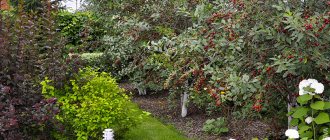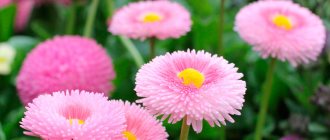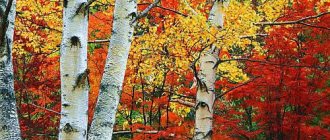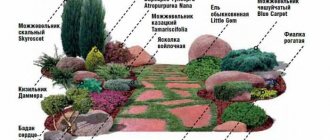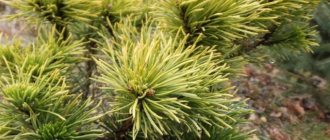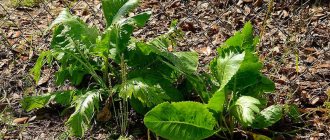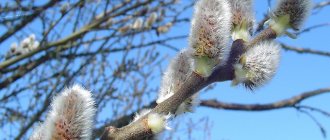Shade-tolerant shrubs for a summer cottage in the Moscow region. Shrubs and conifers
Quite a lot of shrubs have adapted to the lack of sunlight.
Of the flowering shrubs, evergreen rhododendrons are suitable for shade - in their natural habitat they grow on forest edges and among taller shrubs. You can also plant evergreen boxwoods, including creeping form, euonymus and privet - with their leathery foliage they will add shine to the shade. But variegated varieties will lose the beauty of their leaves and become ordinary green. Mahonia holly is also very beautiful and will also bloom and produce blue berries. And the beloved and beautiful hydrangea also feels great in partial shade. This is the most luxurious of the shrubs that winter here. Read more about how to grow and propagate it on the pages of our website.
Some conifers also grow well in areas with northern exposure. For example, yew berry - now there are many varietal plants that do not grow large, and their color can range from yellow to almost black. Other shade-tolerant conifers: fir, larch and most junipers.
Each plant needs to create the conditions in which it will feel comfortable and develop well. There are many types of plants and everyone has different requirements. Let's talk today about shade-loving plants for the garden. Shady areas form in the garden as the trees and shrubs themselves grow. The shadow can be dense or diffuse. Often such areas are a problem for the gardener. How to fill a dark area so that it looks attractive for a long time. A universal solution for this are shade-loving plants, which are famous for their lush or openwork foliage. As a rule, their flowering is not as abundant as that of light-loving plants, but the foliage has a different color and texture.
An example of a corner mixborder near the path leading to the house
The concept of such flower beds is quite simple. You choose one, two or three woody plants (they will be the dominant ones in your mixborder), and line the rest of the space with flower crops. Please note that a flower garden with variable flowering will be more interesting, which means select seedlings that will bloom one after another.
Very often there are situations in which it is necessary to resort to landscape tricks, which we also decided to mention in this article.
If you need a vine that can quickly cover an inconspicuous corner, pay attention to the five-leaf maiden grape. This is a magnificent plant that can grow under the forest canopy and twine around the inconspicuous trunks of tall, two-hundred-year-old spruce trees. In autumn, the leaves turn all shades of red, and quite unusually: with the first frosts, the upper leaves turn red, and (when the wind moves) fresh green leaves are also visible under the red leaves.
Beech "Dawyck Purple" - has a columnar shape with purple leaves. A plant for places where the sun appears at least 4 hours a day. In autumn the leaves turn light brown. It grows quite slowly in our area, but, unlike other coniferous columnar plants, it does not need any shelter.
It also happens that the patio at the house faces the northern part and, apart from annual flowers, which must be planted every year as container plants, it is difficult to choose anything. Evergreen boxwood will come to the rescue! It grows slowly, making it perfect for container gardening. Ideal for those who like something unusual, as it easily supports any topiary shape.
By choosing all of the above shade-loving, unpretentious plants for the garden, you can easily decorate your site, even if it is in a forest area!
We bring to your attention a video in which the landscape designer of our garden center will talk about the most popular plants for growing in shady areas:
Shrubs for deep shade. Shade-tolerant shrubs: types, content
To create a seasoned style, gardeners often plant shrubs that can withstand shade near the gazebo and in other shady areas. They decorate the corners of the garden, they only need a few hours of rarefied light a day.
Plants that do well without bright sunlight fill shaded areas in the garden, including many fruits and berries. For landscape design, decorative deciduous and shade-growing shrubs are planted. Lush flowering perennials create hedges, paths, arches, they decorate the walls of houses, alleys, squares, gazebos, many exude a pleasant aroma, conducive to relaxation.
Also read:.
Fruit bushes for shady corners of the site
Fruits are grown as decoration for the garden and to obtain a tasty and healthy harvest.
Choose:
- Barberry is an evergreen or deciduous plant up to 2 m. The leaf plates collected in bunches are small and leathery. Flowers form clusters on side shoots. The berries appear in mid-summer. They contain useful substances and vitamins. Used in cooking and medicine.
- Hazel (hazel) is a shrub of the Birch family. Known as hazelnut. The leaves are wide, oval. The flowers are light green, similar to earrings. The fruits ripen in early autumn.
- Viburnum - the plant is used to make hedges of any height and shape. It tolerates shade, but then the berries do not ripen. The bark of a young shrub is smooth, then turns gray. The leaves are large, up to 10 cm, pubescent below. On the eve of leaf fall the plant turns red. The flowers are decorative, white. Berries with a high content of vitamins have a healing effect.
- Gooseberry is a berry bush up to 2 m tall with a woody stem and scales. It blooms in May, begins to bear fruit in August, contains many vitamins and microelements, is consumed fresh and stored for the winter.
- Rosehip is a deciduous shrub, has erect or creeping stems covered with thin thorns, loves partial shade, grows up to 1.5 m and higher. Flowers are white, pink, berries are orange-red, medicinal.
Blooming
Representatives of this species are highly decorative and can decorate any, even the darkest, corner.
Rhododendron
The name of a spectacular plant from the Heather family consists of two parts: “rhodon” - rose and “dendron” - tree. In the wild, the culture grows in Asia: China, Nepal, the Himalayas, Japan. Loves partial shade of the coastal zone, mountainous terrain. Shrubs can be creeping or growing upward. Peduncles of some species reach up to 0.2 m in diameter and look stunningly beautiful. Painted in purple, pink, scarlet, lilac, white shades. Some representatives exude a pleasant, sweet aroma. Rhododendron tolerates lack of light well; in such “extreme” conditions, other plants may die. The culture needs standard care. It needs to be fed, weeded, pruned in time, and sprayed during drought.
rhododendron
Syringa
Although the plant comes from the fertile Mediterranean, it is cultivated in absolutely any area of central Russia. It adapts to almost any weather conditions. The bush has a lush crown. It blooms from mid-summer, and incredibly fragrant, small white flowers appear on numerous shoots. Jasmine is literally buried in inflorescences; they cover the green foliage. Tolerates drought and high soil moisture well, and is unpretentious to the amount of sun. Jasmine is notable for the fact that its inflorescences contain a huge amount of essential oils. They have a positive effect on human health: they calm the nervous system, regulate the activity of the gastrointestinal tract, if used as the main component of a healing decoction. The bush is not only an unpretentious garden decoration, but also a gardener’s personal healer.
syringa
Weigela
It is found naturally in the South-East of Russia and in Asian countries. Even a beginner can cope with cultivation. Watering must be done during periods of drought, weeding, loosening, and feeding once a season is sufficient. A unique feature of weigela is its double flowering. The first time it occurs in the second half of May, the second time at the end of summer. The flower stalks are extremely spectacular. Depending on the variety, they have different diameters, tubular, collected in numerous lush inflorescences. Various colors: pink, white, yellow, orange, red.
weigela
Deytsia
An exotic shade-loving perennial shrub native to East Asia will transform the most gloomy corner of the garden. It blooms with openwork white or pink flowers collected in tassels. It will not grow higher than 1 m. If the bush is not trimmed, it spreads greatly in width, so it is often used as a low hedge. The only thing you have to take care of is covering it for the winter. Temperatures below 25 degrees can destroy the plant.
action
Hydrangea
A very elegant crop with a height of 1 to 3 m. It blooms profusely from the beginning of summer to the end of September. Peduncles are white, purple, pink, lilac and even blue. Collected into balls or cones. The less light the bush receives, the darker its color. Hydrangea can be planted in tubs, moving it to any convenient place. It looks beautiful in a bouquet. New shoots form at the cutting site. If you want to give the bush lushness, you need to trim off the old shoots. The culture is extremely unpretentious, the main thing is not to forget to water and feed once a season.
hydrangea
Lilac
This beautifully blooming shrub in late spring can be found in almost every garden and park. Most often it is planted in front of northern windows to admire the picturesque view. Lilac is absolutely not capricious. It doesn’t care about the amount of light, soil composition, or soil moisture. Its root system is so powerful that the bush survives without additional watering. It blooms in clusters of small flowers, collected in lush cone-shaped brushes. Color white or purple. The aroma is sweet. Lilacs are beautiful to cut, but can cause headaches due to their intrusive aroma.
lilac
What shrubs to plant in partial shade. Shade-loving perennial garden shrubs
It happens that on the territory of a dacha or garden plot there are shaded places. And at the same time, there are not so many well-lit places. The reasons for the fact that there are many shaded places on the site can be very different. So, for example, shrubs and trees grow in large numbers on it. They, of course, produce delicious fruits and berries, but they take up quite a lot of space and cast a rather voluminous shadow. Therefore, plants growing under them are almost completely deprived of sunlight. However, few summer residents would not want their entire summer cottage to be beautiful and originally designed. The way out of this situation is very simple. So, in shaded places you only need to plant shade-loving perennial garden shrubs.
How to choose shade-tolerant shrubs for the garden
Shade-tolerant perennial shrubs are conventionally divided into 3 different groups, namely: berry, flowering, and decorative deciduous. Each of these plants has both certain pros and cons. And there are also types of shrubs that not only look very impressive, but also produce healthy, aromatic and incredibly tasty fruits. Experienced gardeners and summer residents categorically do not recommend buying planting material at spontaneous markets, since there is a high probability that it will be of very low quality. It is best to purchase seedlings in special stores that have a good reputation. Among the various types of shrubs, the most popular and widespread can be identified.
Shade-tolerant flowering shrubs
Rhododendron
This shrub has a very impressive appearance, especially during the flowering period, when it is almost completely covered with inflorescences consisting of flowers of rich color. Its leaf blades are fleshy. Rhododendron thrives in the shade created by tall trees and shrubs, in which many other plants can simply die.
Garden jasmine
This shrub is very popular among gardeners and summer residents. This very beautiful plant will be an excellent decoration for almost any area. Jasmine looks especially impressive during the flowering process. At this time, its branches are covered with snow-white lush inflorescences, from which a very pleasant and quite strong smell emanates. An important advantage of such a shrub is its undemandingness to the place of growth, as well as to the quality of the soil. It can adapt to absolutely any growing conditions. So, it can withstand dry periods well, and it is also not afraid of fairly frosty winters. However, in order for your site to be decorated with a compact and neat bush, it will need to be trimmed systematically and often enough.
Shade-tolerant berry bushes
Such perennial plants are suitable for those gardeners and summer residents who want the plants they grow to be not only very beautiful, but also to bring certain benefits.
Barberry
This shrub is quite popular in eastern countries. It is fast-growing and frost-resistant. It is quite easy to care for and also tolerates dry periods very well. This shrub has small, very beautiful leaf blades, which in the fall change their green color to rich burgundy. Barberry produces berries that have high taste qualities. They are used in cooking to prepare a variety of dishes.
Gooseberry
It can grow in both sunny and shaded places. And such a shrub needs to be watered quite rarely and moderately, and it can withstand a dry period. The plant produces very tasty berries, which are often used to make jam.
Hazel
This plant prefers to grow only in non-acidic soil. If the soil is acidic, then it is recommended to add sand to it. Quite tasty nuts grow on hazel.
Shade-tolerant decorative foliage plants
This group includes many plants. Here are some of them.
Forsythia
This plant has spectacular leaves of a rich lemon color. It can be planted either together with other shrubs or alone. It is frost- and drought-resistant, and also easy to care for.
Euonymus
This shrub grows very quickly and does not require special care. In winter, it also looks quite impressive. Leaves of rich color will certainly add zest and unique charm to your garden.
Mahonia
This evergreen shrub loves moisture. If there is systematic watering, it will become very lush and can even bloom.
Such shade-tolerant shrubs will be a wonderful decoration for any site.
Palms and large trees
Dracaena
A charming fluffy palm with narrow, long leaves on a divided stem. It lives well away from windows, in dimly lit corners. The elegant appearance will help decorate any room: from an office to a bedroom or a nursery. For successful cultivation, ensure stable air humidity and a temperature of about 20-25 degrees.
Monstera
Just as ferns grow in our forests, monsters live in the tropical jungles - in the absolute absence of light, with very high humidity. When planting a monstera in your apartment, make sure that in the future you will have enough space for this powerful plant with huge dissected decorative leaves.
It grows quickly, occupying a large amount of space around - both in height and in width.
Important! Due to the size of the leaves, it is believed that at night the monstera absorbs oxygen and produces carbon dioxide - therefore it is not recommended to keep it in bedrooms. But it will be a wonderful decor for a living room, dining room or office.
Alocasia
A decorative alternative to Monstera with large, but narrow, fleshy leaves, distinguished by light, noticeable wide veins (visible in the photo).
It is unpretentious to light, but it makes a lot of demands on other aspects of care: air humidity, soil, soil composition, temperature stability, a sustained dormant period until spring. Therefore, alocasia is considered a plant for experienced housewives, because without understanding the nuances of care, a flower can simply be destroyed.
Evergreens for shade. Evergreen species
Shade-loving evergreen shrubs will decorate the garden all year round. They are used to create hedges, borders, curtains, ornamental stripes (arabesques) and even garden figures.
Yew berry does not require careful care. It is resistant to frost and wind. Grows in poor soils and easily tolerates drought. Shrubs are used to form various shapes and create a hedge. It looks good in a group and as a separate plant. Yew berry does not tolerate excess moisture in the soil.
Holly holly looks like a real Christmas tree. During the winter holidays, it can be dressed up and turned into a Christmas tree. The resilient plant easily takes root in different soils. During drought it should be watered generously. It can grow even in deep shade. The branches of the bush grow slowly and very densely. The plant is formed after the fruiting period. If you plan to collect fruits, then you need to plant several plants, since the shrub needs cross-pollination. Holly reaches the peak of its beauty in late autumn. In winter, it is covered with green leaves and blood-red fruits.
A popular garden plant is boxwood. It needs to be planted in places protected from the wind. The shrub is especially vulnerable to spring winds. Boxwood is heat-resistant and grows on any soil. If the soil is poor, the bush will grow small but very dense. Boxwood is used to form figures, borders and hedges. It is recommended to cover the plant for the winter. For spherical shapes, special boxes made of wood or plastic with holes are used. Hedges and borders can be covered with fabric. Bushes should be tied up for the winter so that they do not break under the weight of snow. With the onset of warmth, the insulation must be quickly removed so that the boxwood does not lock up and get sick.
Kalmia is a favorite garden shrub in the USA, Canada and European countries. The evergreen leaves of Kalmia resemble bay leaves. The shrub blooms beautifully with large inflorescences of soft pink and white flowers. Kalmiya is drought tolerant, but during hot weather it needs to be watered frequently. She needs acidic soil.
Shade-loving shrubs. Twilight plants
A special decoration of the bushes are the juicy, colorful fruits, which, however, are not always edible
Many types of honeysuckle are shade-loving shrubs. Tatarian honeysuckle deserves special attention, it is unpretentious and beautifully blooming, having many garden forms that differ in the color of the petals (from white to bright red).
No less attractive is the rare alpine honeysuckle with bright red fruits and a very dense crown.
The amazing "Poppy" can grow as a small tree. Edible honeysuckle is also popular, which is more valued for its early, piquantly bitter and very healthy berries.
Hazel and euonymus
The well-known common hazel grows well in the shade. For decorative purposes, it is better to use cultivated garden forms with different leaf colors.
Euonymus can be in the form of shrubs or small trees. They attract attention especially in autumn due to their bright original fruits and beautiful leaf color. Euonymus warty has pink fruits and leaves. And the winged euonymus has crimson-red tones.
Viburnum and elderberry for a shady garden
Various types of viburnum are also characterized by high shade tolerance. They are decorative at any time of the year. Viburnum viburnum is a good choice for the garden. And its healing fruits help with many diseases.
An evergreen, winter-blooming viburnum, laurel foliage is attractive with its white and pink flowers. Ideal for cultivation by inexperienced gardeners.
Elderberry - many shrubs of this genus have long been used as ornamental, food, and medicinal plants. Red or cluster elderberry is particularly unpretentious and can also repel mice well. The fruits of black elderberry are edible. It is advisable to plant this type of plant in a place protected from the wind.
Hydrangeas, Mahonias and Mexican Jasmine
Hydrangeas will perfectly decorate an area in partial shade. They begin to bloom in early summer and until autumn. Their beautiful, large inflorescences will also be attractive in dry bouquets. Not capricious and easy to care for - tree hydrangea. The most spectacular and suitable for growing, for example, in the middle zone is paniculate hydrangea.
Its large-flowered form, “Grandiflora,” is especially noteworthy. Bretschneider's hydrangea looks beautiful with large white flowers, which then turn purple.
Mahonia holly is a compact evergreen shrub with beautiful shiny feathery leaves. In early spring it is decorated with bright yellow inflorescences, and in early autumn - with dark blue edible berries.
Shade-loving shrubs also include Mexican jasmine with orange-scented flowers. After spring flowering it can be pruned short.
Cherry laurel, keria and cotoneaster
flowering shrub
Evergreen shade-loving shrubs include cherry laurel with glossy, dense leaves. In June it is decorated with clusters of fragrant white flowers. This is a rather rare plant for gardens in the middle zone due to its low frost resistance. For reliable wintering it must be covered.
Keria japonica is characterized by long spring-summer flowering, and sometimes repeated autumn flowering. True, keria blooms better in the sun. But it also feels pretty good in the shade. Blooms with large yellow inflorescences.
The "Pleniflora" form is distinguished by its magnificent double petals. Keria does not tolerate frost well and therefore for the winter it is better to cover it and protect it from the cold wind.
Cotoneaster is a deciduous or evergreen plant. These shrubs are very diverse in shape and size. They can be six-meter trees and low-growing shrubs.
Remain on the bush for the winter or fall off. Despite such differences, cotoneasters have common features for which they are valued and loved. All plants have very beautiful leaf colors in autumn and elegant fruits. The shrub blooms in May-June. White flowers emerge from pink buds.
Vegetables
The space in front of the house is often not used in any way due to the fact that the sun does not reach there most of the day. However, there are a number of vegetable crops that are worth growing in the front garden or near the fence on the street side. Help to implement the project:
- Perennial onion varieties. A very practical option, because in addition to lush greenery, it has decorative properties. For example, chives have huge lilac caps that attract bees.
- Beet. Tolerates shade quite well. The root vegetables will be small but sweet. But not everyone likes coarse, large beets.
- Rhubarb. If you water it regularly, there will always be luxurious bushes of this plant along the fence.
- Cheremsha. In early spring, people rush into the forest to collect young and very healthy wild garlic. If it grows well under trees, then it is quite possible to grow it on your site, where light-loving plants do not want to grow.
- Borago. Borage grows best where there is little direct sunlight. It does not require special care, it is not afraid of spring frosts, and is practically not susceptible to diseases and insect attacks. By planting it in front of your house, you can provide yourself with the necessary vitamins.
Borage borage
- Greens and herbs. Any greens you like will produce well in the shade. It is important to provide it with moisture and reserves can be made even for the winter.
- Horseradish. Spicy foliage is actively used by housewives for winter preparations. And it grows equally well both in the sun and in shady areas.
Shade-tolerant trees list. Light-loving and shade-tolerant plants
Through the process of photosynthesis, green plants create organic matter from simple inorganic compounds, releasing oxygen into the atmosphere. Light has a great shaping influence on woody plants, the energy of their growth, flowering and fruiting, the course of natural renewal in nature, for example, the change of tree species in a forest after felling.
According to their response to light, plant groups are divided into:
- Light-loving plants (heliophytes) are plants in which the maximum intensity of photosynthesis (light saturation) occurs at 25-50% of full illumination. The light minimum for them is 10-15% of full daylight, below which the plants begin to die. These are trees and shrubs of open habitats or well-lit ecological niches. Light-loving woody plants have crowns that are see-through and transparent: in evergreen species, the leaves usually live on the shoots for up to 3 years, for example, Scots pine in our climate zone. Pines growing separately form powerful spreading crowns, but in the forest trees, competing for sunlight, become elongated and have much thinner trunks; the lower branches die off on them early.
- Shade-tolerant (sciophytes) are plants that grow and develop better in fairly full light, but can also adapt to low light. This is a large group of woody plants capable of surviving at a light minimum (1-3% of full daylight. In shade-tolerant species, the leaves are usually darker, the crowns are dense and dense, the leaves of evergreens live for 5-10 or more years (up to 30), the lower branches remain alive for a long time and the trunks are slowly cleared of them.The death of oppressed trees in the forest occurs slowly.
On a note
Before choosing plants for a shady area of the garden, a corner of a house or a line along a blind fence, you need to assess the degree of illumination of the area using the following indicators:
- Penumbra - a place where the sun's rays fall in the morning or evening and illuminate the area for only 4 - 6 hours
- Shade – areas illuminated from 1 to 4 hours, or receiving diffuse sunlight
- Deep shadow is a place where sunlight penetrates for only 1 hour, or does not reach it at all.
Having decided on the level of illumination of the area, you can begin to study plants that prefer to grow in the shade, or simply tolerate it well. In other words, the choice must be made between shade-loving and shade-tolerant representatives of the flora. A little patience, and even the most abandoned areas of the garden and a piece of the street in front of the house will become a real paradise!
Unpretentious shade-tolerant flowers for the garden. Perennial shade-loving plants for the garden and their photos
Below are photos and names of shade-loving plants that grow over several seasons.
Lupine (LUPINUS). Family of peas (legumes).
Multileaf lupine (L. polyphyllus) is a perennial shade-loving plant from the slopes of the Rocky Mountains (North America). A powerful bush (up to 80-120 cm high) with straight hollow stems and a terminal racemose inflorescence.
As you can see in the photo, these shade-loving flowers for the garden have beautiful palmate leaves, collected in a rosette on long petioles.



